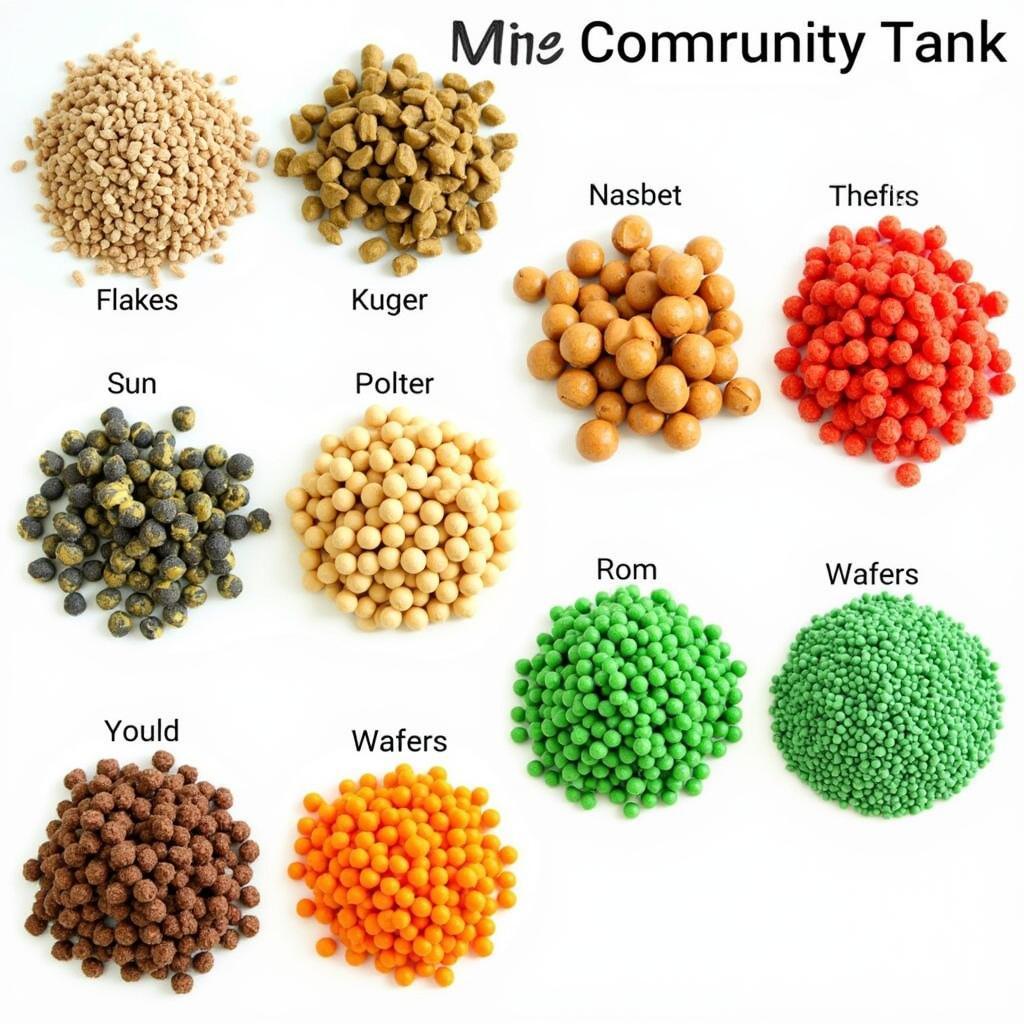Choosing the Best Fish Food For Community Tank can be daunting. With so many options available, it’s crucial to select a food that caters to the diverse dietary needs of your aquatic community. This guide will delve into the essential factors to consider when choosing fish food, exploring different types, and recommending top-quality options for a thriving community tank.  Best fish food for a community tank: A variety of flakes, pellets, and wafers.
Best fish food for a community tank: A variety of flakes, pellets, and wafers.
Understanding Your Community’s Needs
Before diving into the world of fish food, it’s essential to understand the specific dietary requirements of your fish. Are they herbivores, carnivores, or omnivores? Do they prefer sinking or floating food? Considering these factors will help you choose the best fish food brands that provide balanced nutrition and prevent selective feeding. For instance, bottom-dwelling fish may require sinking pellets, while surface feeders thrive on flakes. A mixed community tank often benefits from a variety of food types. What’s the best flake fish food for tetras might not be ideal for your bottom-feeding catfish.
Types of Fish Food: Flakes, Pellets, Wafers, and More
The diverse world of fish food offers a variety of forms to suit different feeding habits and preferences. Let’s explore the most common types:
-
Flakes: A popular choice for many community tanks, flakes are readily available and cater to a wide range of fish. They float on the surface, making them ideal for top and mid-dwelling feeders. You can find flakes tailored to specific species and nutritional requirements. Check out this resource on best flake fish food.
-
Pellets: Pellets come in various sizes and sinking rates, catering to both bottom feeders and mid-water swimmers. They offer concentrated nutrition and are less messy than flakes. Sinking pellets are particularly beneficial for bottom-dwelling species like catfish and loaches.
-
Wafers: These slow-sinking discs are designed for algae eaters and bottom dwellers. They provide essential nutrients for herbivorous species and help maintain a clean tank environment.
-
Live and Frozen Foods: While not a staple for all community tanks, live and frozen foods, like bloodworms and brine shrimp, provide a valuable nutritional boost and can encourage natural feeding behaviors.
-
Freeze-Dried Foods: A convenient alternative to live and frozen options, freeze-dried foods retain much of their nutritional value. They’re a good occasional treat or supplement.
Choosing the Right Food for Your Community Tank
Selecting the best fish food for community tank involves balancing the diverse dietary needs of your fish. Consider incorporating a variety of food types, including flakes, pellets, and wafers, to ensure that all species receive the necessary nutrients.
What are the key nutrients to look for in fish food?
High-quality fish food should contain a balanced mix of proteins, fats, carbohydrates, vitamins, and minerals. Look for ingredients like fish meal, shrimp meal, spirulina, and kelp.
How much should I feed my community tank?
Overfeeding can lead to poor water quality and health issues. Start with a small amount of food and observe how much your fish consume within a few minutes. Adjust the amount as needed to avoid leftover food. Avoid feeding more than your fish can consume in 2-3 minutes. If you’re unsure about feeding practices, explore the available fish food brands and their recommendations.
Can I use betta food for my other tropical fish?
While betta food is formulated specifically for bettas, other tropical fish can occasionally eat it. However, it’s not ideal for long-term feeding as it may not provide the balanced nutrition required by other species. Find out more about this topic here: can tropical fish eat betta food.
Ensuring a Thriving Community
“A well-fed fish is a happy fish,” says Dr. Amelia Rivers, a renowned aquatic veterinarian. “Providing a varied and nutritious diet is essential for maintaining the health and vibrancy of your community tank.” By carefully selecting the right fish food, you can create a thriving underwater ecosystem. This includes not only providing the correct nutrients but also considering food size and type for your specific community.
Conclusion
Choosing the best fish food for community tank is a crucial aspect of responsible aquarium keeping. By understanding the diverse needs of your fish and selecting high-quality food options, you can create a thriving and vibrant aquatic community. Remember to consider a variety of food types, such as flakes, pellets, and wafers, to cater to the different feeding habits and dietary requirements of your fish. Choosing the right food ensures a healthy and balanced ecosystem within your tank.
FAQ
- What is the best type of fish food for a community tank?
- How often should I feed my community tank?
- Can I mix different types of fish food?
- How can I tell if my fish are getting enough food?
- What are the signs of overfeeding?
- How do I store fish food properly?
- Can I make my own fish food?
For further assistance, you can visit our page about tropical purina fish food or even explore resources related to a fish food pantry lockport if you’re looking for assistance with pet food. You might also be interested in learning more about general fish food brands.
Need help with your community tank? Contact us at Phone Number: 02437655121, Email: [email protected] or visit us at 3PGH+8R9, ĐT70A, thôn Trung, Bắc Từ Liêm, Hà Nội, Việt Nam. We have a 24/7 customer support team.